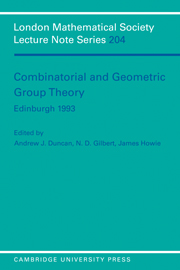Book contents
- Frontmatter
- Contents
- Foreword
- Participants
- On bounded languages and the geometry of nilpotent groups
- Finitely presented groups and the finite generation of exterior powers
- Semigroup presentations and minimal ideals
- Generalised trees and Λ-trees
- The mathematician who had little wisdom: a story and some mathematics
- Palindromic automorphisms of free groups
- A Freiheitssatz for certain one-relator amalgamated products
- Isoperimetric functions of groups and exotic cohomology
- Some embedding theorems and undecidability questions for groups
- Some results on bounded cohomology
- On perfect subgroups of one-relator groups
- Weight tests and hyperbolic groups
- A non-residually finite, relatively finitely presented group in the variety N2A
- Hierarchical decompositions, generalized Tate cohomology, and groups of type (FP)∞
- Tree-lattices and lattices in Lie groups
- Generalisations of Fibonacci numbers, groups and manifolds
- Knotted surfaces in the 4-sphere with no minimal Seifert manifolds
- The higher geometric invariants of modules over Noetherian group rings
- On calculation of width in free groups
- Hilbert modular groups and isoperimetric inequalities
- On systems of equations in free groups
- Cogrowth and essentiality in groups and algebras
- Regular geodesic languages for 2-step nilpotent groups
- Finding indivisible Nielsen paths for a train track map
- More on Burnside's problem
- Problem Session
On bounded languages and the geometry of nilpotent groups
Published online by Cambridge University Press: 05 April 2013
- Frontmatter
- Contents
- Foreword
- Participants
- On bounded languages and the geometry of nilpotent groups
- Finitely presented groups and the finite generation of exterior powers
- Semigroup presentations and minimal ideals
- Generalised trees and Λ-trees
- The mathematician who had little wisdom: a story and some mathematics
- Palindromic automorphisms of free groups
- A Freiheitssatz for certain one-relator amalgamated products
- Isoperimetric functions of groups and exotic cohomology
- Some embedding theorems and undecidability questions for groups
- Some results on bounded cohomology
- On perfect subgroups of one-relator groups
- Weight tests and hyperbolic groups
- A non-residually finite, relatively finitely presented group in the variety N2A
- Hierarchical decompositions, generalized Tate cohomology, and groups of type (FP)∞
- Tree-lattices and lattices in Lie groups
- Generalisations of Fibonacci numbers, groups and manifolds
- Knotted surfaces in the 4-sphere with no minimal Seifert manifolds
- The higher geometric invariants of modules over Noetherian group rings
- On calculation of width in free groups
- Hilbert modular groups and isoperimetric inequalities
- On systems of equations in free groups
- Cogrowth and essentiality in groups and algebras
- Regular geodesic languages for 2-step nilpotent groups
- Finding indivisible Nielsen paths for a train track map
- More on Burnside's problem
- Problem Session
Summary
Abstract
Bounded languages are a class of formal languages which includes all context free languages of polynomial growth. We prove that if a finitely generated group G admits a combing by a bounded language and this combing satisfies the asynchronous fellow traveller property, then either G is virtually abelian, or else G contains an element g of infinite order such that gn and gm are conjugate for some 0 < n < m.
The introduction of automatic groups [5] has precipitated a host of questions about the roles which formal language theory and geometry play in the study of normal forms for finitely generated groups, particularly groups which arise in geometric settings. For example, when a group G is given as the fundamental group of a compact Riemannian manifold, words in a fixed set of generators for G have a natural interpretation as paths in the universal cover of the manifold; it is natural to ask how the geometry of the manifold is reflected in the linguistic complexity of normal forms for elements of G. The results presented here and in [3] can be interpreted as providing a partial answer to this question in the case where the manifold under consideration is a quotient of a nilpotent Lie group.
Information
- Type
- Chapter
- Information
- Publisher: Cambridge University PressPrint publication year: 1994
Accessibility standard: Unknown
Why this information is here
This section outlines the accessibility features of this content - including support for screen readers, full keyboard navigation and high-contrast display options. This may not be relevant for you.Accessibility Information
- 1
- Cited by
